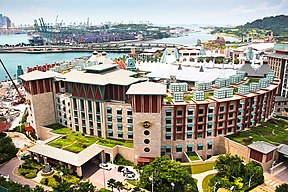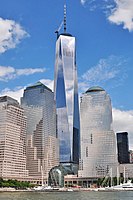
Back عمارة معاصرة Arabic Müasir memarlıq Azerbaijani Сучасная архітэктура Byelorussian Съвременна архитектура Bulgarian Zeitgenössische Architektur German Arquitectura contemporánea (2000-presente) Spanish Nykyarkkitehtuuri Finnish Architecture contemporaine French Ժամանակակից ճարտարապետություն Armenian Arsitektur kontemporer ID
Top: Resorts World Sentosa by Michael Graves; Center left: One World Trade Center by David Childs; Center right: Makkah Royal Clock Tower by Mahmoud Bodo Rasch; Bottom: Beijing National Stadium by Herzog & de Meuron | |
| Years active | 2000–present |
|---|---|
| Location | International |
Contemporary architecture is the architecture of the 21st century. No single style is dominant.[1] Contemporary architects work in several different styles, from postmodernism, high-tech architecture and new references and interpretations of traditional architecture[2][3] to highly conceptual forms and designs, resembling sculpture on an enormous scale. Some of these styles and approaches make use of very advanced technology and modern building materials, such as tube structures which allow construction of buildings that are taller, lighter and stronger than those in the 20th century, while others prioritize the use of natural and ecological materials like stone, wood and lime.[4] One technology that is common to all forms of contemporary architecture is the use of new techniques of computer-aided design, which allow buildings to be designed and modeled on computers in three dimensions, and constructed with more precision and speed.
Contemporary buildings and styles vary greatly. Some feature concrete structures wrapped in glass or aluminium screens, very asymmetric facades, and cantilevered sections which hang over the street. Skyscrapers twist, or break into crystal-like facets. Facades are designed to shimmer or change color at different times of day.
Whereas the major monuments of modern architecture in the 20th century were mostly concentrated in the United States and western Europe, contemporary architecture is global; important new buildings have been built in China, Russia, Latin America, and particularly in Arab states of the Persian Gulf; the Burj Khalifa in Dubai was the tallest building in the world in 2019, and the Shanghai Tower in China was the second-tallest.
Additionally, in the late 20th century, New Classical Architecture, a traditionalist response to modernist architecture, emerged, continuing into the 21st century.[5] The 21st century saw the emergence of multiple organizations dedicated to the promotion of local and/or traditional architecture. Examples include the International Network for Traditional Building, Architecture & Urbanism (INTBAU),[6] the Institute of Classical Architecture & Art (ICAA),[7] the Driehaus Architecture Prize,[8] and the Complementary architecture movement. New traditional architects include Michael Graves, Léon Krier, Yasmeen Lari, Robert Stern and Abdel-Wahed El-Wakil.
Most of the landmarks of contemporary architecture are the works of a small group of architects who work on an international scale. Many were designed by architects already famous in the late 20th century, including Mario Botta, Frank Gehry, Jean Nouvel, Norman Foster, Ieoh Ming Pei and Renzo Piano, while others are the work of a new generation born during or after World War II, including Zaha Hadid, Santiago Calatrava, Daniel Libeskind, Jacques Herzog, Pierre de Meuron, Rem Koolhaas, and Shigeru Ban. Other projects are the work of collectives of several architects, such as UNStudio and SANAA, or large multinational agencies such as Skidmore, Owings & Merrill, with thirty associate architects and large teams of engineers and designers, and Gensler, with 5,000 employees in 16 countries.
- ^ Creating Your Architectural Style. Pelican Publishing. 15 September 2009. ISBN 978-1-4556-0309-1.
- ^ Urban, Florian (2017). The new tenement. New York: Routledge. ISBN 978-1-315-40244-4. OCLC 1006381281.
- ^ Dickinson, Duo (2017). "Does the New Traditionalism Have A Point?". Common Edge. Retrieved 29 April 2021.
- ^ Wainwright, Oliver (4 March 2020). "The miracle new sustainable product that's revolutionising architecture – stone!". The Guardian. Retrieved 29 April 2021.
- ^ Boylan, Alexis L., ed. (2011). Thomas Kinkade: The Artist in the Mall. Durham [N.C.]: Duke University Press. ISBN 978-0-8223-4839-9. OCLC 658200776.
- ^ Crysler, Christopher Greig; Cairns, Stephen; Heynen, Hilde, eds. (2012). The SAGE handbook of architectural theory. Los Angeles: SAGE. ISBN 978-1-84860-039-3. OCLC 797835437.
- ^ Adam, Robert (Fall 2004). "INTBAU Shares ICA&CA's Mission" (PDF). The Forum. Institute of Classical Architecture & Art. Archived (PDF) from the original on Apr 17, 2023.
- ^ Haddad, Elie; Rifkind, David, eds. (2016). A Critical History of Contemporary Architecture: 1960-2010. London: Routledge. ISBN 978-1-315-26395-3. OCLC 973142750.



